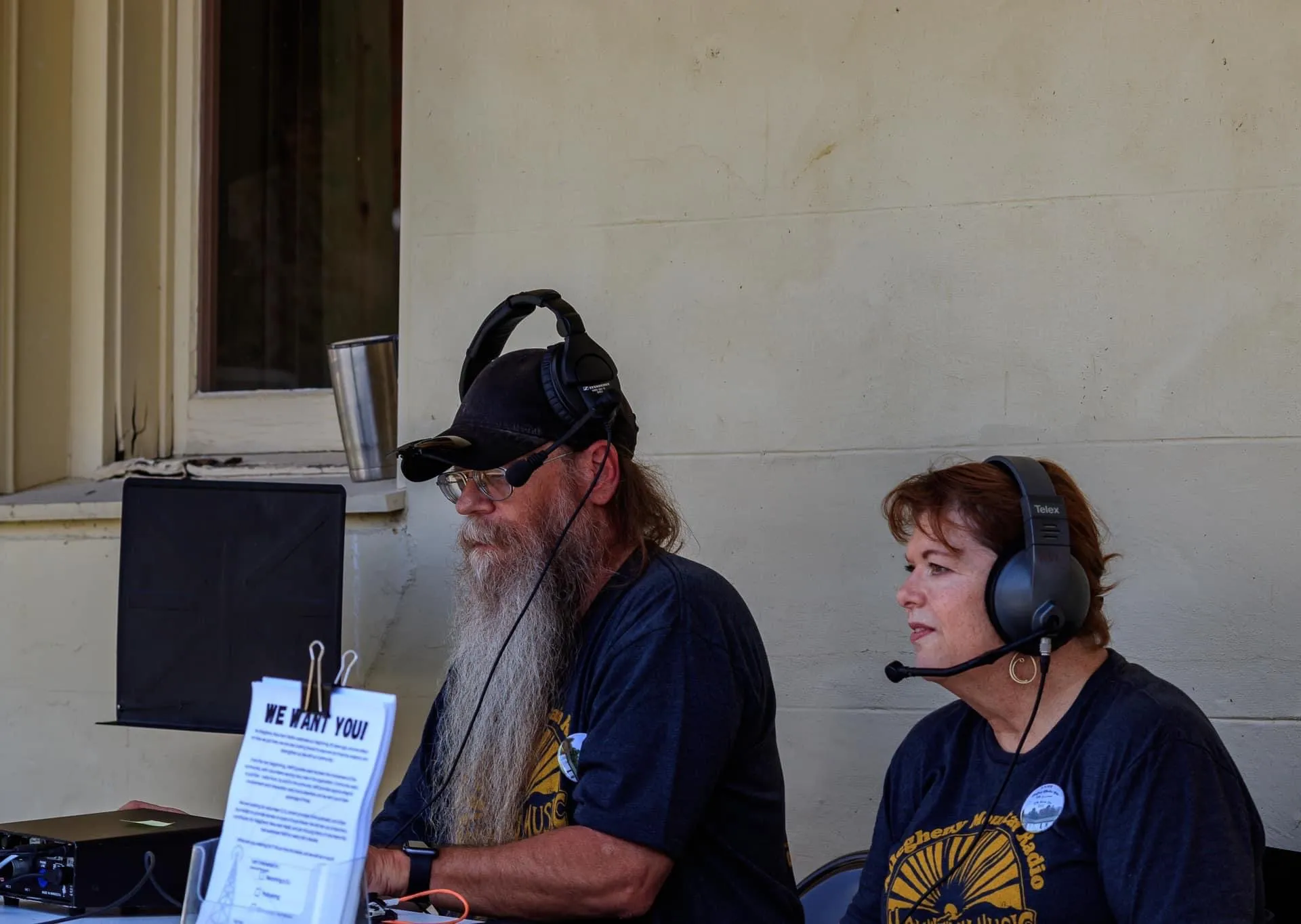For Scott Smith, the cuts to the Corporation For Public Broadcasting are existential.
He is the general manager of Allegheny Mountain Radio, which he runs alongside programme manager Heather Nidly. The funds were slashed as part of United States President Donald Trump’s vast tax cut and spending bill that was signed into law in July. As a result, the station, which has been on air for more than four decades, lost 65 percent of its funding.
“We are here to serve our communities and to fulfill our mission of giving them news, giving them entertainment, giving them emergency alerts and giving them school closings. We do lost and found pet notices. We do funeral announcements. We have a listing of community events that is read multiple times a day. We do weather forecasts. We’re a critical part of the community,” Smith told Al Jazeera.
The rescissions bill that Trump signed allows the US Congress to claw back funding that had been approved and pulls back $9bn in funding, including $1bn from the Corporation for Public Broadcasting (CFB). At the end of September, those funds officially dried up.
The money had already been allocated by the previous Congress to fund public media for 2026 and 2027. Now stations are scrambling to find ways to fill the holes.
The Trump administration has gone after news organisations that have presented any critical coverage of him, including the Wall Street Journal, after its coverage of a suggestive letter purportedly written by Trump to the late sex offender Jeffrey Epstein for his birthday. In September, he tried to sue The New York Times for allegedly being a “virtual mouthpiece” for the Democratic Party.
His leverage over public media is significant because that is partially funded by federal tax dollars. The White House first signed an executive order to defund public media in May. That was quickly blocked because funding decisions are made by Congress, not the White House.
Next, Trump pressured Congressional Republicans to put forth the rescissions bill that fulfilled the mission of his previous executive order. To justify his call for cuts, in May, the White House released a list of segments from NPR and PBS programmes that it says had liberal bias, as it included many segments about the experience of the trans community.
The White House also cited a report alleging PBS favoured Democrats. That report was from the openly partisan Media Research Center, which has a stated goal to promote conservative values.
A key, but overlooked, problem with the cuts is that they overwhelmingly harm stations that do not even cover the White House or much national politics at all.
Allegheny Mountain Radio (AMR) is one of those stations. Comprising three affiliates for three counties straddling the West Virginia and Virginia border, on their airwaves, listeners will find gospel, folk and country music, as well as coverage of local football games and town hall meetings.
AMR carries NPR’s national newscast and, more importantly, serves as the on-the-ground voice when severe weather hits.
Unlike in other regions of the county, there is no other alternative to get real-time local news. The nearest local news station is several hours away, separated by winding country roads. When there’s severe weather, AMR is the only way locals get vital information like road closure announcements because of floodwaters.
“Just a few years ago, we had a deluge of rain coming down and flooding parts of the county. At that point, when something like that happens, the radio station really is the only way to get that information out quickly to our listeners and let them know where it’s happening,” AMR programme manager Nidly told Al Jazeera.
AMR is in a part of the country where cellphone signal and wireless access are sparse because of its proximity to what is called the National Radio Quiet Zone (NRQZ) near the Green Bank Observatory, which limits the use of radio frequency and other signal methods so that they do not interfere with their equipment. This requires special equipment to point radio signals away from the observatory.
With the region’s low population density, there’s a limited business case for a station. But there is a case for public service. The community depends on AMR for emergency alerts – even on a personal level. During major storms, Smith said, people have shown up at their stations when their phones stopped working, asking if AMR could broadcast a message to let their family and friends know they were safe.
Despite their strong community focus, these stations may not benefit from the same level of donor support seen by larger public stations across the country, due to limited local enterprise and resources.
It is trying. In order to stay afloat, the station is actively soliciting donations on its website.
While small community stations – like those serving Bath and Pocahontas Counties in West Virginia, and Highland County, Virginia, through AMR – don’t produce national newscasts or air segments that ruffle feathers in Washington, they are still the ones that are most at risk of being hit hardest.
“Small stations like ours are the ones who will suffer because of these cuts. We feel like we are the baby that got thrown out with the bathwater because there’s so much emphasis on the talking points around NPR and PBS. It’s like the rest of us, the small community stations, have absolutely been forgotten in this equation,” Smith told Al Jazeera.
The cuts, however, hit stations across the US in big markets too. WNYC in New York City lost 4 percent of its funding. WBUR in Boston, San Francisco’s KLAW, and KERA in Dallas, Texas, all saw 5 percent cuts.
Stations like these have large donor bases or “listeners like you”, as their hosts say during pledge drives. Big market stations might be able to make up the difference, says Alex Curley, a former product manager at NPR who recently launched a platform called Adopt A Station, which shows which public media stations are at most risk of losing funding.
“When you think about stations that rely on federal funding for 50 percent or more of their revenue, it’s not because they’re asking for a handout. It’s a literal public service for those stations,” Curley told Al Jazeera.
But in counties where the population is sparse and industry is limited, that donor base is not as plentiful. That’s the case with AMR.
“We are in a very rural area. We are an area where there are not a whole lot of businesses. So that amount of income simply cannot be made up through extra donations or extra underwriting,” Smith added.
In a July Substack post, Curley, who was involved in NPR station finances until he left the network in 2024 amid layoffs, said that 15 percent of stations are at risk of closure. His website has provided some reprieve.
“I only expected maybe a few dozen people to visit the site. My biggest hope was to get a couple of donations that went towards a station at risk. It’s [the website] been shared thousands of times. I’ve even heard from stations that were identified as being at risk of closing. They told me they’re getting an influx of donations from out of state through the site. It’s been an incredible response,” Curley said.
However, he argues, this is a temporary fix.
“The real danger will be in six months, a year, two years, when people have forgotten about public media. These stations basically are losing federal funding forever. Donations in the short term are really great, but in the long term, they’re going to have to figure out ways to keep donors engaged and to keep donations flowing to them, or they might close,” Curley added.
“Public radio is also a lifeline, connecting rural communities to the rest of the nation, and providing life-saving emergency broadcasting and weather alerts. Nearly 3-in-4 Americans say they rely on their public radio stations for alerts and news for their public safety,” NPR’s Katherine Maher said in a statement on July 18 following the Senate vote.
“In fact, while the Senate considered amendments, a 7.3 earthquake struck off the coast of Alaska, prompting three coastal stations to start broadcasting live tsunami warnings, urging their communities to head to high ground,” Maher said.
Maher declined Al Jazeera’s request for an interview
PBS faces similar pressures, and many of its stations are also at risk of closure, according to Adopt A Station’s data.
“These cuts will significantly impact all of our stations, but will be especially devastating to smaller stations and those serving large rural areas. Many of our stations, which provide access to free, unique local programming and emergency alerts, will now be forced to make hard decisions in the weeks and months ahead,” PBS president and CEO Paula Kerger said in a statement after the Senate vote.
Kerger did not respond to Al Jazeera’s request for additional comment.
The push to defund public media isn’t a new one for the GOP. Republicans have long argued that the media is not a core function of government. In 2012, GOP presidential nominee Mitt Romney said he would eliminate subsidies to PBS – during a debate moderated, ironically, by then PBS NewsHour anchor Jim Lehrer.
In the 1990s, then House Speaker Newt Gingrich promised to “zero out” funding for CPB, arguing it should be privatised. And in the 1980s, Ronald Reagan attempted to slash $80m from public media – roughly $283m today – though Congress blocked the move.
Following global cuts
Cuts to the Corporation for Public Broadcasting are the latest wave of the White House cutting back on government-funded media arms, including reductions to the US Agency for Global Media, led in part by senior adviser Kari Lake.
Lake is a former Phoenix, Arizona, news anchor known for denying the 2020 election results in which Trump lost to Democrat Joe Biden for the presidency. She is also known for promoting baseless conspiracy theories and for refusing to accept her own defeat for governor and senator bids in Arizona in 2022 and 2024, respectively.
She has been behind the agency effectively shuttering Voice of America (VOA), which has not published any new stories or uploaded new videos to its YouTube page since mid-March.
Last month, a federal judge in Washington blocked the firing of workers at VOA, which affected more than 500 staffers. The Trump administration called the decision “outrageous” and vowed to appeal.
Radio Free Europe/Radio Liberty, which broadcasts in 27 languages across 23 countries, faced challenges similar to VOA. However, the European Union has helped keep the network up and running with $6.2m in emergency funding.
Representatives for the US Agency for Global Media did not respond to our request for comment.
Looming threats to free expression
These cuts come alongside other threats to freedom of expression in the private sector. Soon after the funding cuts were signed into law, Paramount announced the cancellation of The Late Show. The host, comedian Stephen Colbert – a longtime critic of the president – had only days earlier called out Paramount, the show’s parent company, for settling a lawsuit with Trump.
The suit stemmed from Trump’s claim that an interview with his 2024 presidential rival Kamala Harris was doctored. Although the network had initially called the lawsuit meritless, it ultimately settled for $16m. Colbert called the settlement a “big fat bribe”, noting that Paramount had a then-pending merger with Skydance Media – owned by David Ellison, son of Oracle CEO Larry Ellison, a key Trump ally. The merger has since been approved. Paramount has said that the decision is purely financial in nature.
Months later, following stand-up comedian Jimmy Kimmel’s comments on Charlie Kirk’s death, Federal Communications Commission (FCC) Chairman Brendan Carr appeared on a right-wing podcast to criticise the remarks and urged Disney – the parent company of ABC, where Jimmy Kimmel Live airs – to cancel the show.
Nexstar Media Group – one of the largest TV station operators in the US, and which is waiting on an FCC approval of its merger with Tegna – announced it would no longer carry the programme. Disney subsequently suspended the show, though the decision was short-lived, as it returned to the airwaves within a week.
The White House did not respond to Al Jazeera’s request for comment.















